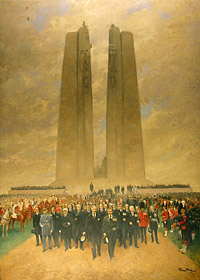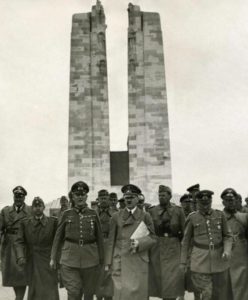1936
Dedication of the Vimy Memorial
After World War I Canadians were anxious to remember their deeds and their dead in monumental form; all across the country hundreds upon hundreds of local statues, cairns, and cenotaphs were erected. The government also planned to memorialize battle sites in Europe with a series of identical monuments in Belgium and France and held a competition for designs. When over 160 proposals were submitted in 1921, what emerged was overwhelming support for a single spectacular construction based on a design by architect Walter Allward, on Vimy Ridge where Canadian troops had won a bloody victory in 1917. France agreed to donate land to Canada in perpetuity for such a memorial, provided Canada was responsible for its upkeep.
The monument was years in the making, partly because of the difficulty in finding and transporting exactly the right stone. The original plan called for marble but this was deemed to be too susceptible to erosion in the climate of northern France and builders chose instead a type of limestone found in Croatia — it had been used in Diocletian’s palace at Split built 1,650 years earlier and was still in fine shape. 6,000 tonnes of the stone had to be quarried and moved to Vimy while 11,000 tonnes of concrete and hundreds of tonnes of steel were being employed on the foundation.
An enormous pilgrimage of veterans was planned for the official dedication in 1936. Politicians, military units, bands, and clergy were in abundance, presided over by King Edward VIII, performing one of his few official duties before his abdication.
During World War II, the site was in German-occupied France and rumours spread that the Nazis would desecrate the memorial. In order to dispel such stories the German government published pictures of Adolf Hitler triumphantly visiting the monument and showing that it was still being preserved.

